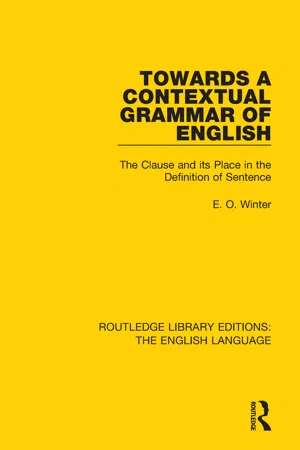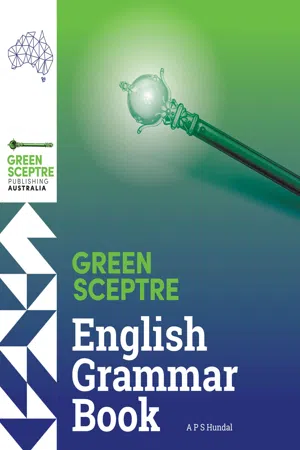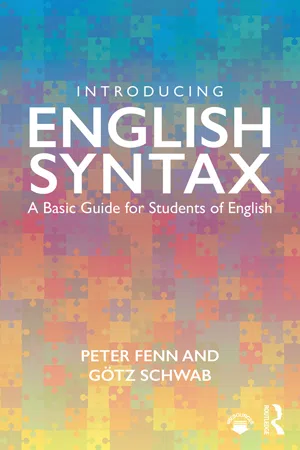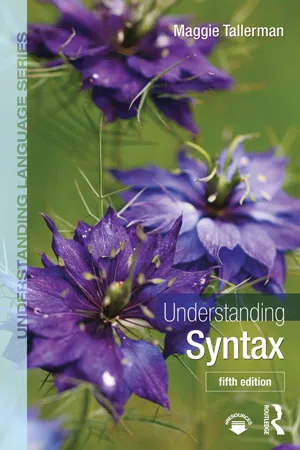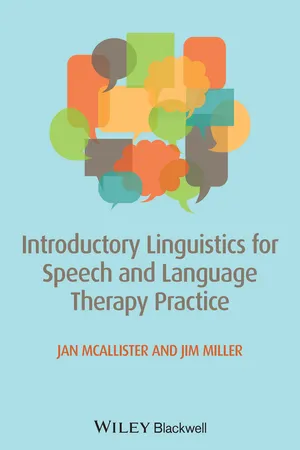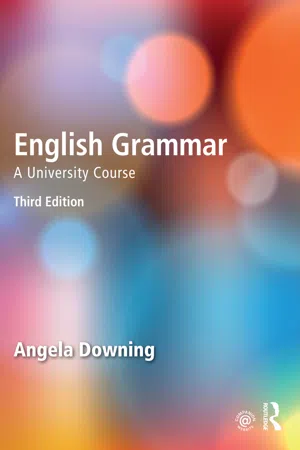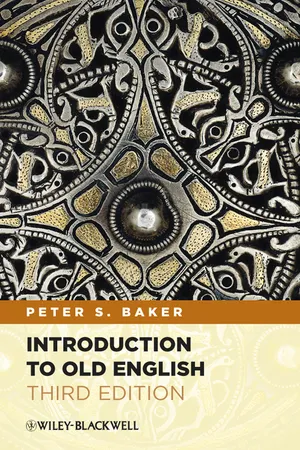Independent Clause
An independent clause is a group of words that contains a subject and a predicate and can stand alone as a complete sentence. It expresses a complete thought and does not depend on another clause for its meaning. Independent clauses are essential building blocks in constructing clear and coherent sentences in any language.
8 Key excerpts on "Independent Clause"
- eBook - ePub
Towards a Contextual Grammar of English
The Clause and its Place in the Definition of Sentence
- Eugene Winter(Author)
- 2020(Publication Date)
- Routledge(Publisher)
...I find that we require three complementary requirements to explain the communicative function of Independent Clause: (i) a requirement for grammatical and semantic completeness, (ii) a requirement to be told what you don’t know in terms of what you do know, and (iii) a requirement to take the sentence on trust as true unless otherwise signalled. 11.4 Definition 1 in Two Parts 11.4.1 Introduction As already stated, the definition of sentence is a definition of Independent Clause. As such it is also a definition of subordinate clause since subordinate clause is a basic function of its (main) clause, which means it cannot exist as a clause without the (main) clause to which it is subordinated. At its simplest, this first definition requires that a sentence be both grammatically complete and semantically complete within the bounds of their propositional notions about the topic (clause relational units) as these are signalled by the clause. In this two-part definition, the intelligibility of the second part is a function of the first. 11.4.2 Definition 1.1: Requirement for Grammatical Completion This part requires that the clause not merely be grammatically complete but have the grammatical status of independence so that we would expect the sentence to consist of one or more clauses, one of which is at least independent...
- eBook - ePub
- APS Hundal(Author)
- 2022(Publication Date)
- Green Sceptre Publishing Australia(Publisher)
...Clauses It is a combination of words in a sentence definitely consisting of a subject and a verb. It is smallest grammatical unit expressing thought. The word “clause” is derived from latin word “clausa”, meaning closing the period. Mainly there are two types of clauses: 1. Independent Clause 2. Dependent Clause Independent Clause A group of words having a subject, a verb and making a complete thought. It can alone stand as a sentence. This clause is also called main clause as it alone has enough information to convey complete message. It is also called grammatically complete sentence. It can also be explained as (subject+ verb+ complete thought = Independent Clause). Example My Dog likes bones. Here subject is the “Dog”, verb is “likes “and sentence is conveying complete thought. Dependent clause A group of words in a sentence consisting of a subject and a verb yet it expresses incomplete thought, which needs main clause as support to make complete sentence. That’s is why it is called subordinate clause or dependent clause. It cannot stand as a complete sentence by itself as it leaves an idea unfinished. For example: The team can’t start playing soccer until coach arrives. (Until coach arrives is a dependent clause. It contains subject “coach” and verb “arrives” still the clause is dependent on other to give complete thought.) Further, there are three types in dependent clause: • Adjective Clause • Adverb Clause • Noun Clause Adjective clause It is a dependent clause that modifies noun or pronoun in the sentence. This clause begins with the words such as: • That • When • Who • Whom • Whose • Which • Why For instance The sports class that Sahil takes focuses on technique. Mr...
- eBook - ePub
Introducing English Syntax
A Basic Guide for Students of English
- Peter Fenn, Götz Schwab(Authors)
- 2017(Publication Date)
- Routledge(Publisher)
...If we make the clauses into separate sentences, as in b. and c., of course the ellipted subject in a. must be reintroduced in c. (otherwise we would not have a complete sentence). What we are saying here, then, is that when sentences become clauses, they often have to be integrated into the syntax of the larger sentence. As we will see later, this adaptation can be quite drastic, making some clause types look very different from how they would have to look if they were independent sentences. Nevertheless, every clause can be called a sentence-like unit, and this is so for a simple reason: every clause has its own separate verb phrase (functioning, as we will see in Chapter 2, as predicator). p.31 We have used the term sentence to illustrate what a clause is. But actually we can define the clause quite independently of the sentence: • A clause is a unit of phrases held together by one of them in the role of predicator. • The predicator must always be a verb phrase. This will allow us to reverse the logic above and define sentence in terms of clause: • A clause or group of connected clauses that can stand alone syntactically is known as a sentence. • A sentence consisting of just one clause is known as a simple sentence. • A sentence consisting of more than one clause is known as a multiple sentence. In Chapter 4 we will go into detail on multiple sentences, distinguishing two kinds: compound sentences and complex sentence s. But for the moment we will let this aspect of the matter rest there. 1.4.3 The phrase The phrase is the most basic unit in sentence analysis. The major phrases of a sentence or clause are its immediate constituents, i.e. those phrases not contained inside any other phrases. These major phrases are the first elements that must be identified before we can establish sentence functions, as we will see in Chapter 2. In a simple sentence, all sentence functions are filled by phrases...
- eBook - ePub
- Maggie Tallerman(Author)
- 2019(Publication Date)
- Routledge(Publisher)
...3 Looking inside sentences This chapter begins an examination of the internal structure of sentences which takes up the remainder of the book. Section 3.1 examines finite and non-finite verbs and auxiliaries, and distinguishes between simple sentences and complex sentencess – sentences which contain other sentences. Subordination is the term used for a construction in which a sentence is embedded (or contained) within another sentence. Section 3.2 is an introduction to subordination in English and other languages. Although subordination is common cross-linguistically, not all languages seem to make much use of it. Section 3.3 examines some cross-linguistic variation in clause types, particularly in complex constructions. 3.1 FINITENESS AND AUXILIARIES 3.1.1 Independent Clauses Linguists often divide the sentence into two main parts: the SUBJECT and the PREDICATE. As we saw in Chapter 2, the central role (or ‘head’) in the predicate is normally filled by a verb, but we also find other types of predicate, such as adjectival predicates and nominal predicates. A verbal predicate consists of the head verb plus any phrases modifying the verb, or selected by the verb. Let’s examine the data in (1). In (1a), the subject is Charlie and the predicate waited ; in (1b) the subject is these guys and the predicate like chips ; and in (1c), the subject is the whole phrase The first-year students in our department and the predicate is bought a lot of books at this stage in the term. These examples each illustrate SIMPLE SENTENCES. ‘Simple’ here is a technical term, meaning ‘consisting of just one clause’. To avoid conflict with the (non-linguistic) idea of a sentence as something that starts with a capital letter and ends with a full stop, here I introduce the more precise term CLAUSE. The term ‘clause’ has a specific meaning: it’s a sentence that contains one predicate. As we will see in this chapter, some sentences contain only one clause, and others contain more than one clause...
- Jan McAllister, James E. Miller(Authors)
- 2013(Publication Date)
- Wiley-Blackwell(Publisher)
...We will have a great deal more to say about clauses in the next two chapters, but for the purposes of the present chapter, we can define a clause as a sequence of words like (36a) or (36b), which contains a verb (was or slipped in our examples) and can stand alone as simple sentence. The main verb may be modified by one or more auxiliaries, and the clause may also contain a variety of phrases. 3 Exercise 7.4 How many clauses do the following sentences contain? 1. Linguistics is important although it is sometimes complicated. 2. What is your name and age? 3. What is your name and when were you born? 4. Measure two ounces of butter, melt it in a pan and add the onions. 7.5.1 Elements of the clause Descriptions of typical and atypical language development and of language impairment in acquired disorders often include analysis at the level of the clause, because a person who is struggling linguistically may find it difficult to process (produce or understand) all of the constituent parts of the clause accurately. Consequently, many language assessments that SLTs use investigate the clause level; so SLTs need to be able to recognise the elements of the clause. In Section 7.4.8 we noted that on one interpretation the ‘verb phrase’ consists of a main verb plus any associated auxiliary verbs and that this corresponded to the verbal element at the clause level. In the context of a discussion of elements of the clause, we often refer to the verbal element simply as the ‘verb’, but be aware that this may be more than a single word. When analysing a clause, we have to specify what this verbal element is, and also identify any other phrases in the clause, the order in which they occur and the relationship between each phrase and the verbal element. Verbal elements combine with the sorts of phrases described in Section 7.4: noun phrases, adjective phrases, prepositional phrases and adverb phrases...
- David Hornsby(Author)
- 2014(Publication Date)
- Teach Yourself(Publisher)
...A more technical use of the term grammar refers to the stored linguistic knowledge in the brain of an individual, which enables him/her to produce well-formed (i.e. grammatical) sentences in his/her mother tongue – though not necessarily in a standard or prestige variety. This is what Chomsky refers to as competence (see Chapter 8). For linguists, syntax means the study of the set of rules governing the way that morphemes, words, clauses and phrases are used to form sentences in any given language. However, the distinction between ‘word-level’ and ‘sentence-level’ grammar is far from watertight, and there is a considerable grey area between the two. Linguists sometimes refer to morphosyntax when describing phenomena which straddle both levels: grammatical gender, for example, often manifests itself at word level in inflection, but may also affect relations between items within a sentence in the case of the syntactic phenomenon of agreement (or concord). Subjects and predicates Calling syntax ‘the grammar of sentences’ is all very well, but sentences prove as difficult to define as ‘words’ did in the previous chapter. We are used, in literate societies with a written-language bias, to thinking of a sentence as something that generally begins with a capital letter and ends with a full stop, but this does not get us very far. A traditional definition of a sentence as ‘the expression of a complete thought’ is not helpful either: are elderberry wine, exactly or good! not ‘complete thoughts’? In traditional grammar, sentences were required to have a subject and a predicate, i.e. something we are talking about (the subject) and then something said about it (the predicate): 1 Dinosaurs existed. 2 Samantha is preparing for her bar examinations. 3 Paul gave a tip to the waiter. Identifying the subject in Latin, Russian or Polish would be straightforward, because the nouns would be case-marked, i.e. inflected according to their function in the sentence...
- eBook - ePub
English Grammar
A University Course
- Angela Downing(Author)
- 2014(Publication Date)
- Routledge(Publisher)
...For instance, the previous sentence is a unit containing other units such as a recognised pattern and in speech and writing. Sequences such as defined as any and repeated regularly in, which also occur in the same sentence, do not constitute units since they have no semantic whole and no syntactic pattern. The following sequence, which comments on the effects of a nuclear accident, constitutes one syntactic unit which is composed of further units: The effects of the accident are very serious. In English, it is useful to recognise four structural units which can be arranged in a relationship of componence on what is called a rank-scale : Figure 1.7 Units on the rank scale. For the initial stages of analysis it may be helpful to mark off the boundaries of each unit by a symbol, such as those adopted in the example. The symbol for ‘clause boundary’ is a double vertical line ||, that for ‘group boundary’ is a single vertical line |, and that for ‘word boundary’ is simply a space, as is conventionally used in the written language. The Independent Clause is the equivalent of the traditional ‘simple sentence’. Combinations of clauses, the boundaries symbolised by |||, are illustrated in 2.4.1 and treated more fully in Chapter 7. The relationship between the units is, in principle, as follows. Looking downwards, each unit consists of one or more units of the rank below it. Thus, a clause consists of one or more groups, a group consists of one or more words and a word consists of one or more morphemes. For instance, Wait ! consists of one clause, which consists of one group, which consists of one word, which consists of one morpheme. More exactly, we shall say that the elements of structure of each unit are realised by units of the rank below. Looking upwards, each unit fulfils a function in the unit above it...
- eBook - ePub
- Peter S. Baker(Author)
- 2012(Publication Date)
- Wiley-Blackwell(Publisher)
...They are called ‘participial phrases’ when they function as adjectives and ‘gerund phrases’ when they function as nouns, but there is no difference in form. It is a tale told by an idiot. Giving alms may help you get to heaven. Prepositional phrases consist of prepositions and their objects. They function as adjectives or adverbs: Variety is the spice of life. We live in Scottsville. Never judge a book by its cover. A phrase can contain any number of words and can also contain clauses and other phrases, which can in turn contain other clauses and phrases. 3.3 Clauses A clause is a group of words that contains a subject and a finite verb. It is rather like a sentence in this respect, and in fact a simple declarative sentence (such as ‘I like ice cream’) is nothing more than an Independent Clause standing by itself – it is indeed the defining characteristic of an Independent Clause that it can stand by itself. But a sentence of any complexity also contains one or more subordinate clauses. A subordinate clause is a sentence-like group of words (containing a subject and a verb) that functions as a word in another grammatical structure – in a sentence, clause or phrase. Subordinate clauses are classified according to the kinds of words they can stand in for: nouns, adjectives and adverbs. Noun clauses in Modern English begin with such words as that, which, what and whoever. A noun clause may function as the subject or object of a verb, as a complement, or as the object of a preposition; in fact, a noun clause can come pretty much anywhere a noun can come. Examples: You said that you would be here today. What you thought you saw was an illusion. Whoever wins will be a wealthy man. Adverb clauses are extremely various and very common...
